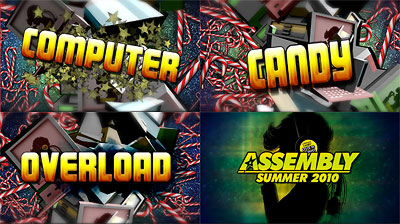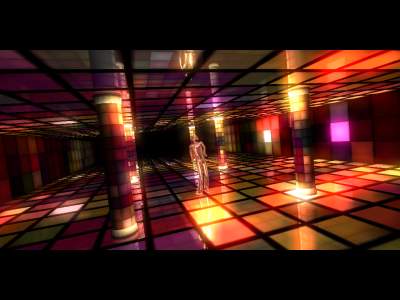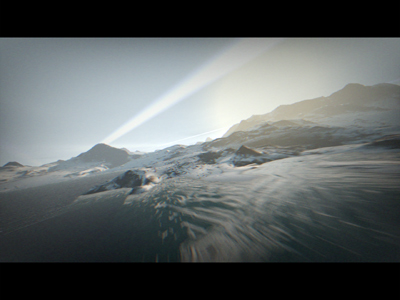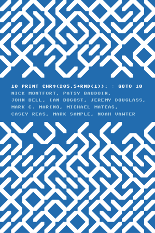Here’s an effective remix: Every space shuttle launch. The audio, as well as the difference in that one cell of video, draws attention to most memorable one, and the array of all of them drives home that the space shuttle launches _can_ be presented in their entirety – the program is over. The video is by McLean Fahnestock.
“Taroko Gorge”: The Vandalism Continues!
As I wrote a few days ago, I made a statement about “Taroko Gorge,” and all of its vandals, at the ELO conference in Morgantown, WV.
Sepand Ansari created a Beckett-based “Taroko Gorge” remix at the ELO conference. And now I have the URL for this piece, “Waiting for Taroko Gorge.”
Kathi Inman Berens has created “Tournedo Gorge” “to mash the space of computation with the female, domestic, and tactile,” as she discusses in her blog post.
A Note on Stacking
In February 2011 Tim Schafer’s Doublefine Productions released a game, Stacking, in which the anthropomorphic figures are Russian nesting dolls. Set in a nicely developed Victorian world of social ills and technological marvels and making use of a toy-like mechanic, Stacking is somewhat like Lego Star Wars without either the Lego or the Star Wars brand. It combines charming play with plenty of cutscenes.
Some aspects of the game don’t seem to have been mentioned online in the past year and a half, so I’m compelled to mention them now: You play by controlling a young boy and nesting this character, and then others, inside one another to gain access to different areas and accomplish tasks. Your current stack of dolls can grow only by entering another doll. It’s not possible to stack another doll if it’s facing you and looking at you, only if you sneak up on it. That is, it’s necessary to enter dolls from behind. When you do pop yourself inside, onlookers gasp in shock.
Just saying.
Deus Ex Machina 2
Mel Croucher created an amazing computer game in 1984: Deus Ex Machina, a ZX Spectrum game that takes the player on an abstract journey through different stages of life in segments of fixed duration; it was sold with an audiotape that provided a synchronized soundtrack. The game is unrelated to the later and more famous Deus Ex. It was ported to the Commodore 64 and the MSX.
Croucher, who has been a writer on computing and was also apparently the first person to broadcast computer games over the radio as digital data, is now developing Deus Ex Machina 2, which will star You (Time’s 2006 Person of the Year) and Sir Christopher Lee.
“Taroko Gorge” at the WVU ELO Conference
_This was my statement for the “Taroko Gorge Remixed” panel yesterday (June 21) at the 2012 ELO conference. The panel was organized by Mark Sample and also featured Scott Rettberg, J. R. Carpenter (who joined us by video chat), Talan Memmott, Eric Snograss, Flourish Klink, and Andrew Plotkin. In attendance and part of the discussion were Leonardo Flores and Sonny Rae Tempest, who did work based on the Taroko Gorge code after the panel was proposed._
It is curious that I was invited to be part of this panel today, for I am the only speaker in this session who has not created and released a remix of Nick Montfort’s “Taroko Gorge.”
Today, however, to remedy this mismatch, to bridge this gap, to traverse this gorge, I am releasing a remix of my poetry generator, “Taroko Gorge.” This new work that I have completed and placed online today is also called “Taroko Gorge.” This remix was created to be an elegant poetry generator, producing a boundless nature poem and inspired by the experience of walking through Taroko Gorge National Park in Taiwan. The code of the program is the same as that of the original, and the text used as strings in the generator is also the same as that of the original. No comments have been added.
So, how can one distinguish this new “Taroko Gorge” from the original poetry generator of the same name? For one thing, I have placed today’s date on the right side of the page, to indicate that _this_ is the remix that was completed today. When citing this work, you must also include the date that you accessed this page to comply with MLA, Chicago Manual of Style, and other bibliographic standards. If you leave the “Taroko Gorge” page open long enough, staring at it with meditative bliss, rapt attention, or monomaniacal trembling, you should include a date range rather than a single date in your bibliographic entry.
But enough of the temporal dimension. In addition to including a date, the new version of “Taroko Gorge” includes the names of all known vandals, those who have replaced my own lyrical words and phrases with ones associated with various other individual visions, ranging from the idiosyncratic to the downright perverse. These appear on the right-hand side – stricken out. Since it is not proper to condemn people without evidence – unless we put them aboard a plane and take them to another country – I have also included links to the offending Web pages.
This remix of “Taroko Gorge” asserts something very simple: that the rebirth of the author comes at the expense of the death of other authors. Something simple, about originality, voice, and purity of essence, which has been said in so many ways: Remix = death. Take back the gorge. Don’t tread on me. There’s a bear in the woods. Make it old. I did it my way. Under the page, the code.
Translating Clemente Padin
Ottar Ormstad made the case for non-translation at the recent Paris 8 conference on the translation electronic literature. He eloquently explained that many explorations of language (including concrete poems) do not lend themselves to either ordinary translation or a simply explanatory note. This was a reasonable point that is appropriate to many works of concrete and sound poetry.
To illustrate this point, he displayed this concrete poem by Uruguayan poet Clemente Padin.

Very compelling! This is an amazing poem that is quite language-specific. And yet, I was compelled to translate it to English, and have done so below:
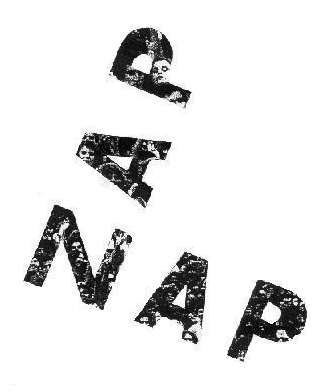
The original message, that PAN (bread) converges with PAZ (peace), cannot be communicated precisely in every way. But, using the same characters as in the original poem, I can assert that people should ZAP their NAP and wake up to our reality, in which the needs of our fellow people must be met before peace can be attained.
Head Over to Overhead
I just saw an overhead projector demo, at a demo party, that simulated the Amiga boing ball demo using only transpaencies. And then another that, using pinwheels, simulated fire.
I regret that the overhead projector did not, in either case, produce the music.
The End of ppg256
I presented the last ppg256 poem (ppg256-7) in Paris today at &Now.
Here are the current versions of all of the ppg256 poems/programs:
Gamer vs. Scener, or, Scener Theory
_I delivered this as the opening keynote at DiGRA Nordic 2012, today, June 7._
#### 1. The World of the Scene
Welcome to the world of the scene, to the summer of 2012, to that Earth where the demoscene is pervasive. Computers are mainly part of our culture because of their brilliant ability to produce spectacles, computationally generated spectacles that are accompanied by music, all of which is produced from tiny pieces of code, mostly in assembly language, always in real time. The coin of the realm is the demoscene _production,_ which includes graphics and chiptunes but is principally represented by demos and their smaller cousins, intros. The coin of the realm – although these are not exchanged commercially, but freely shared with all lovers of computation and art, worldwide.
The ability of these programs to connect the affordances of the computer with people’s capabilities for aesthetic appreciation, and the ability of programmers to continually uncover more potential in machines of whatever vintage, is the leading light in our world’s cultural activity and in the development of new technology as well. And it burns so brightly.
Computers, originally imagined as instruments of war, as business machines, as scientific apparatus, now are seen as platforms for beauty, as systems that can be rhythmical and narrative and can present architectural and urban possibilities as well as landscapes. One plays with the computer not by picking up a controller that is ready to receive one’s twitches but by thinking and typing at great length, by loading and storing, by writing programs.
People congregate in immense gatherings to program together and to appreciate intros, demos, and other productions running on the appropriate hardware. Of course they attend the classic parties such as Assembly in Helsinki, where they fill the Hartwall Areena. They come as well to the edgy and artsy Alternative Party in Finland. They also travel every summer to this world’s largest American demoparty, Segfault, which takes place at the Los Angeles Convention Center. Few of the sceners are even aware that a small but dedicated group of gamers is meeting at the same time in the same city, in a hotel, for their so-called “E3” gathering.
To exchange creative computer programs with one another, to annotate them and discuss them, a number of widely-used social media platforms have sprung up in our scener world. Some people used the video sharing service YouTube, but it is far less popular than YouCode, which allows the full power of the computer to be tapped and facilitates the exchange of assembly language programs.
In our scener world, a vibrant group of game developers and game players remains, of course, although they are not much talked about in the popular press, in the art world, or in academic discourse. California is something of a backwater in this relatively small pond of game development. Some development of games is still done there – first-person shooters, moderately multiplayer online role-playing games, and so on – but the games that have gained some purchase with the public come from elsewhere.
The two most prominent game developers are from Japan and Wales: Tetsuya Mizuguchi and Jeff Minter. Mizuguchi’s _Rez,_ as with with his many other excellent games, connects music and actions in a way that mainstream computer users – sceners – find particularly compelling. Minter’s graphical prowess, seen in _GridRunner_ and many other games, appeals to the popular crowd of sceners, too, as does his whimsical inclusion of ungulates in his games. The games by these two consistently have earned the highest level of praise from the world at large: “that could almost be a production.”
#### 2. Scener vs. Gamer
Now, as enjoyable as this vision is, let’s put this scener world on hold for a moment – not, of course, by pressing select on our XBox 360 controller, but by pressing the freeze button on our Commodore 64’s The Final Cartridge III – or, if we must resort to emulation, by selecting File > Pause from the VICE menus.
How does the scener world that can be glimpsed in the real Summer Assembly in Helsinki relate to this other universe we have surely heard about, the gamer world of Winter Assembly and this summer’s DiGRA Nordic in Tampere? How do the origins of computer and videogaming relate to the origins of the scene?
To relate gaming and the scene, something of course must be said about the nature of the demoscene. I am not here to provide a history of the scene, which is, of course, almost entirely a Northern European phenomenon and which is particularly strong in Finland. It would be absurd for me to come here and pretend to be an authority on the scene, ready to tell you the special things that I know and that you should know about it. It would be as absurd as my coming to tell you about how to properly use a sauna or about the strategic virtues of land mines. I come not to bury the scene in a dense, pedantic explanation – I come to praise it and to offer it my imagination, to embrace and extend it in the most non-proprietary way. My interest is in making the scene mine – and everyone’s. To do so, I will describe a bit about how the scene originated.
The idea of creating an impressive demo that will do something pleasing, playful, and impressive, and that will make use of computing technology, is probably a good bit older than the general-purpose computer. In the early days, it made no sense to divide the category “demo” from that of “game.” Consider the amazing computational project by Spanish engineer Leonardo Torres y Quevedo. This individual, who as part of his day job devised a type of semi-rigid airship that still excites steampunks, created a special-purpose automatic electronic chess player. This system was like the famous mechanical Turk, but with no dwarf inside. Torres y Quevedo’s incredible demo could play a chess endgame perfectly and even had a voice synthesis system – a phonograph – that enabled it to annouce check and checkmate. Since there were no demo parties at the time, his system was permiered at the World’s Fair, in 1914. Possibly the first demo (not on a general-purpose computer, to be sure, but an incredible and impressive demo nonetheless) was executed almost one hundred years ago, and was also possibly the first computer game. If World War I had not ensued the demoscene might have begun in full force the early years of the twentieth century, anticipating and perhaps inspiring general-purpose computers.
There were other demos and other game-demos in the days before the demoscene proper. In the former category were “recreational computing” programs developed at MIT to convert numbers from Arabic numerals to Roman numerals and back and the remarkable joke called “Expensive Typewriter,” which is possibly the first word processor; in the latter were _Tennis for Two,_ perhaps the playful TX-0 demo _Mouse in the Maze,_ and certainly the PDP-1 program _Spacewar._ The scene would have certainly applauded projects like these, along with the work of those who made the line printer produce music and who made pleasing sounds with radio interference on their Altair 8800.
While demos – usually what would be called “wild” demos and would do not fit into any standard demoscene category – abound throughout the twentieth century, the modern-day demoscene has a specific origin. This community, this constellation of creative practice, exists thanks to commercial game software and to the copy protection techniques used on it. The demoscene begins in the confluence of a computer game industry and the impulse to enforce legal restrictions on copying with technical ones. First, certain microcomputer disk drives working in certain modes can be used to _read_ data slightly better than they can _write_ data. Producers of video games – to be honest, not massive horrifying hegemonic corporations, in the early days, but often literaly mom and pop operations such as Sierra On-Line (Ken and Roberta Williams), Scott Adams games, Jordan Mechner, and so on – joined with early videogame publishers to implement so-called _copy protection_ for games delivered on floppy disc.
Copy protected discs could not be copied using the typical methods that one might employ to back up one’s own data. But they could be copied, sometimes using bit copiers with particular parameters and sometimes thanks to the efforts of early digital preservationists who performed an operation upon them known as _cracking_. By reverse-engineering these games and their protection schemes, and by twiddling a few bytes, crackers were able to liberate copy-protected games and allow ordinary users to make the legitimate backup copies to which they were entitled. While I was content to sector-edit my Apple II discs and change my _Bard’s Tale_ characters to have abilities of all 99s, and satisfied myself with placing my Apple //e and my duodrive and monitor in the trunk of my car and heading off to a copying party where warez could flow “the last mile” to end users, others, fortunately, did the difficult and elite work of liberating games in the first place.
This was another time, you understand – 1983-84 – and we had not recieved Bill Gates’s open letter to hobbyists that, had we read it, would have explained to us that we were stealing software. People would have ceased to crack and copy software if they knew that they were killing the game industry. And all the home computer software that is available and runnable today _only_ in cracked versions – now that the companies that were responsible for such software are gone completely or are nothing but a few confused lines on legal documents – all that software would be gone, immolated, left on the ash heap of history, like tears in rain.
But I am not discussing guilt, innocence, or disappearance; I am mentioning how the demoscene came to be. This activity of cracking software led those who were removing copy protection to enhance the software they were dealing with in certain ways. It was possible to tidy programs up and compress them a bit for easier copying. (This tradition is alive and well in many circles, including even electronic literature. Jim Andrews told the story at the Modern Language Association electronic literature reading of how, when one of his works was being translated into Finnish, Marko Niemi returned not only the translation but also a version of his program that was bug-fixed and tidied up.) If there was a little space on the disc, either to begin with or as a result of this compression, one could add a sort of splash screen that credited those who did the cracking and that pilloried the crackers’ enemies.
This sort of crack screen or “intro” to the game has to fit in a small amount of space; it was sometimes a static image, sometimes animated. Most importantly, it was the mustard seed that grew into the various elaborate productions of the demoscene, almost always non-interactive and no longer introducing any commercial game. Rather, the intros and longer demos that are shown nowadays, like the graphics and chiptunes that are also featured at demo parties, are there for their own sake. They do not introduce games, they do not introduce and flog new technologies, they simply demonstrate, or show, purely. Initially, they demonstrated one trick or a series of tricks tied together by very little – perhaps music, perhaps a certain graphical style. Now, in the era of design, demos tend to offer unity rather than units and often treat a theme, portray subjects, evoke a situation or narrative.
Certainly, the productions I am talking about demonstrate what they demonstrate to a technically adept, pseudonymous audience, groups that assemble or gather at events such as Assembly or the Gathering, mostly in Northern Europe. There are demo parties and parties featuring demos elsewhere, however, such as Block Party in the United States. In Boston, the recently-minted @party even has support from a local arts organization that runs a new media gallery and the Boston Cyberarts Festival.
But enough background; time to figure. The method I have used is not anthropological; I have not gone to ask sceners what they have already clearly said in one book, several articles, and a pair of documentaries. I am instead going to use a method where one talks not to people but to objects, where one reads and interprets specific computational texts. I am going to describe what these demos demonstrate, not technically, or not only technically, but culturally. Mackenzie Wark in his book _Gamer Theory_ argues that games offer us only an atopia, a blank placelessness; the productions of the demoscene, on the other hand, I argue, project utopias – not flawless ones, not ideals beyond critique, but utopias nonetheless. Instead of reading these visions as examples simplistic technofuturism devised by Pollyannas, I look at them as imagining new possibilities.
[I showed three demos running on a borrwed Windows computer – thanks to the conference organizers – and then showed them again without sound, discussing each of them.]
### 3. Computer Candy Overload
Gamers and sceners have often come to the same events — for instance, to Finland’s famous Assembly, up until 2007, when the event split into a gamer-oriented winter gathering here in Tampere and a scener-oriented summer one in Helsinki.
Let’s wait for this to explode …
This demo offers a great deal of junk food, of candy canes. Christmas in July, or, more precisely, in August. We progress, if it’s right to call it progress, backwards – in a retro-grade motion, powering into the past with today’s technology.
The demo we are now experiencing, “Computer Candy Overload” by United, is a special type of production that serves to invite people to an upcoming demo party. It advertises Summer Assembly 2010, of course, but is also an interesting starting point for discussion because it has many typical elements of modern-day demos, showcasing certain technical feats while being brought together by a contemporary concept of design. It took first place at @party the first year of that event, in 2010.
In this part of the demo, the flying clusters of objects that were seen earlier are still hurlting backwards through the air, but now, a generated city – an immense city, like a planar version of Issac Asimov’s planet-wide Trantor – is not only scrolling by as we fly backwards above it. The city is also rocking out, pulsing with the beat of the music, as much character as setting. The city, and then the planet.
Now, the direct address to @party, where this demo was released …
Now, the shout-outs, the naming of the most famous demoscene groups that will show themselves, and show their productions, at Assembly …
The shapes of the city again, first radial, then rotating on cubes …
This demo also offers us a flatted female image, a silhouette of the stereotypical hot chick licking a 9 volt battery – bringing together adolescent erotocism with, perhaps a titilating adolescent memory of a a literally electric encouter. To some, it could suggest that a woman can contribute approximately one bit, or one tongue, to the activities of the demoscene – that women can be at best mascots.
That would be an antagonistic reading, but consider that the cyborg-like woman is turning the industrial product of the battery from its intended use in consumer goods to the purpose of sensory stimulation. She is entering into an aesthetic relationship with this compact power source. And, as her image appears on row after row of homogenous computer monitors, she turns the banal laboratory and the corporate workplace into the creative frenzy of the demo party.
### 4. fr-025: the.popular.demo
[An anti-virus warning came up at this point – the demo had been identified as a dangerous program. With the help of Finnish-speakers, I indicated that the computer should run the program.]
As game companies outsource the production of full motion video to pad their products with pre-rendered cutscenes, the demoscene, interested in “the art of real-time,” insists on rendering during execution and limits precalculation. This real-time quality is present in all demos, including the one shown earlier and the one other demo I will show. This one, “The Popular Demo” by farbrausch, was the 1st place PC demo from Breakpoint 2003. Yes, everything you see was produced by almost ten-year-old code, code that is practically classic.
Again, a reading that takes note of gender is interesting. Here we have an exuberant, highly reflective dancing figure. This dancing figure becomes first a trio of dancers and then a crowd. And this crowd, even if the original figure is slightly androgynous, is a crowd of dancing guys, relfecting not only the light but the typical almost entirely male demo party. Actually, the figure seems to me to be male because of the silvery Jockey shorts he is wearing.
We could chastise the demoscene for its lack of inclusiveness and for its occasional sexualization of women, but compare these demos to the recently released trailer for the videogame _Hitman Absolution,_ in which a group of women dressed as nuns casts off their habits, is seen to be wearing sluttly attire and sporting weapons, and then, after attacking the extremely bad-ass hitman, go on to be slaughtered one by one in gruesome detail. This trailer is not really that innovative in the area of violence against women — it simply conflates numerous action-movie clichés. But it still makes a much worse impression than demoscene productions do, because these productions are not, ultimately, about dominance and sadism. Demoscene productions are about exuberance, about abundance, about harmony. If they overlook or slight women now and then, this is a failing that should be remedied. It is one that can be remedies without altering the core dynamic of the scene and of productions.
Demoscene productions can be dark at times, but even when they are more industrial or grim, they are about elements working together and in sync. There is no player being thwarted by the stutter-step of the attacking computer, no need to break the pattern – only a pleasing spectacle, a dance of color and computation, a dance that results from the connection between coder and computation.
### 5. Elevated
[As I was starting this one, a conference organizer said “please! The lowest resolution! This one is very demanding!”]
As games become more and more extensive in terms of assets and total program and data size, the demoscene flies into smaller and smaller pockets of inner space, creating self-contained 64K demos and 4K intros that run on standard operating systems – one scener, Viznut, even described in late 2011 how “256 bytes is becoming the new 4K.” Viznut, by the way, is from a country that starts with F, where people still smoke a reasonable number of cigarettes, that is not France. Viznut’s recent work has been to creating a 16-byte VIC-20 demo and to develop numerous very short C programs that generate music when their text output is redirected to /dev/audio.
The demo, or more precisely, intro that we are watching now is considerably larger, although all the code for it will comfortably and legibly fit on the screen. This is “elevated” by Rgba & TBC, the 1st place 4k Windows intro from Breakpoint 2009.
Notice the highly mannered, highly artificial way that the so-called camera (completely a second-order construction of the code, of course), calling attention to itself constantly, moves over this model of the natual world, this landscape. The landscape itself approaches the sublime, but the musical score and the movement and cutting work against that sublimity at least as much as they work to evoke it. And what could cut against the sublime more strongly that these beams of light, emanating as if from a club, or several clubs, calling the viewer to think of the music as diegetic, to imagine it happening on this alternate Earth.
Just as the city pulsed to the beat in “Computer Candy Overload,” just as the planet itself did, here the landscape remains static but emits these club-like clarions of light. The terrain itself is part of the party, nature blended with man without being violated. The elevated landscape is augmented without being touched so it can also kick out the jams.
### 6. Platform Studies & _10 PRINT_
A notable distinction between the demoscene and gaming is seen in their relationship to platform. Demoscene productions celebrate and explore the different capabilities of specific platforms, old and new, while the pressures of the market compel cross-platform game development, the smoothing over of platform differences, and the abandonment of older platforms. I don’t mean to say that game developers themselves aren’t aware of the differences between a mobile phone and a desktop, or even between an XBox 360 and a PC, which have very similar hardware but are distinct, for many reasons, as platforms. I simply mean that the impulse in game development is to try to smooth over the differences between platforms as much as possible, while those in the demoscene seek to explore and exploit particular platforms, showcasing their differences.
Ian Bogost and I have developed an approach to digital media that follows the demoscene in its concern for particular platforms, what they can and cannot do, and what their construction and use has to say about computing and culture. The approach is called platform studies, and book-length scholarly works using this approach are now being published in the Platform Studies series of the MIT Press.
_Racing the Beam: The Atari Video Computer System_ by Nick Montfort and Ian Bogost is the first book in this series. … The second book is _Codename Revolution: The Nintendo Wii Platform_ by Steven E. Jones and George K. Thiruvathukal … The third book in the Platform Studies series is _The Future Was Here: The Commodore Amiga_ by Jimmy Maher …
In November, the MIT Press will print my next collaboratively-written book, which will be part of a different but related series – the Software Studies series. This book is _10 PRINT CHR$(205.5+RND(1)); : GOTO 10_ by Nick Montfort, Patsy Baudoin, John Bell, Ian Bogost, Jeremy Douglass, Mark C. Marino, Michael Mateas, Casey Reas, Mark Sample, and Noah Vawter. You may have noticed that the title is practically unpronounceable and impossible to remember, and that the list of authors – there are ten of us – is also impossible to remember. We call the book _10 PRINT,_ and if you remember that you should be able to find out about it.
The book is an intensive and extensive reading, in a single voice, of the one-line Commodore 64 BASIC program that gives it its title. It is a transverse study of how this program functions, signifies, and connotes at the levels of reception, interface, form and function, code, and platform, considering both the BASIC language and the Commodore 64 as platforms. We discuss the relationship of randomness to regularity in this program and in computing, with one chapter devoted to randomness and one to various types of regularity, including the grid and iteration. We trace the academic origins and entrepreneurial implementation of BASIC for the Commodore 64, a programming language that was customized for the Commodore 64 by Ric Weiland and originally written for the 6502 processor by none other than Bill Gates himself. And we explain how the Commodore 64 shared features with other microcomputers of its time and was also distinct from them.
_10 PRINT_ is not a book about games, nor a game studies book, but it is a book that discusses computer games and relates them to another area of creative computing, hobbyist programming. The _10 PRINT_ program itself is neither a game nor a demo, but the book discusses the demoscene about as much as it does gaming, situating the practice of programming and sharing one-liners among these other practices.
The Library of Congress has assigned a call number for this book that places it among manuals for the BASIC programming language, so perhaps the book will be not only hard to recall by title and author but also hard to locate in libraries. It should be easy to read in another way, however, because like the demos I have been showing and discussing, like the 10 PRINT program, the _10 PRINT_ book will be made available online for free. The elite will want to purchase the beautiful physical object, a two-color book with custom endpapers designed by Casey Reas, the co-creator of Processing – but we make scholarship for the masses, not the classes.
But enough about books. Welcome back to the world of the scener, a world of parties, a world of exploring computation and the surprising abilities of specific platforms, a society of the spectacle that everyone can make. Here in the world of the scener, we are all equal and we are all totally elite. Think about a few questions this raises: Should your scholarship be distributed under the gamer model or the scener model? Are games all that can be done with computers, the only productions worth study, commentary, theorizing, and intellectual effort? I’m not inviting you to the next Assembly. I’m inviting us to see creative computing for what it is, something that includes videogames alongside hobbyist computing alongside digital art alongside electronic literature alongside the demoscene. Some of you know that it can be done, some believe that it can be done – so, a shout-out to you. And thanks to everyone for listening.
_The three demos I discussed are all available in executable form at pouet.net, which I have linked to and from which I have appropriated the three images. There is video documentation of them linked there, too._
Computational Creativity: MIT at ICCC
Many exciting things here at ICCC-12 (the International Conference on Computational Creativity 2012) in Dublin, but here are those that come from MIT, Writing and Humanistic Studies, and Comparative Media Studies:
I represented my lab, The Trope Tank, by presenting by the position paper “Small-Scale Systems and Computational Creativity” by Nick Montfort and Natalia Fedorova. The Trope Tank has a longer technical report that deals with this topic, written for a more general audience: “TROPE-12-02 – XS, S, M, XL: Creative Text Generators of Different Scales” by Nick Montfort.
One of the demos here, “Exploring Everyday Creative Responses to Social Discrimination with the Mimesis System,” by D. Fox Harrell, Chong-U Lim, Sonny Sidhu, Jia Zhang, Ayse Gursoy and Christine Yu, is the work of Harrell’s ICE (Imagination, Computation, and Expression) Lab at MIT. Harrell presented this demo yesterday, showing the current state of the iPhone game Mimesis, developed as part of the Advanced Identity Representation project.
Adventuresome Clara Fernandez
There’s a nice new interview with game scholar and game maker Clara Fernandez, who is an affiliate of The Trope Tank. Check it out.
Computational Literacy: Get with the Program
Mark Sample has posted five basic statements, ahem, I mean 5 BASIC statements, on computational literacy.
I must point out that while they are all programs, the third and fifth ones actually include multiple statements. And, the program that number 4 is referring to is:
10 PRINT "GOODBYE CRUEL WORLD"
20 NEW
Very much worth a read – from the standpoint of understanding programming and its cultural intersections generally, not *only* because Mark is promoting the book that he, I, and eight others wrote, which will be published in November.
Christian Bök in Purple Blurb *Thursday* 6pm
Update: Thanks to Francisco Ricardo, a video of some of Christian’s Purple Blurb reading is now online.
The Spring 2012 Purple Blurb series comes to an end this week, not with a whimper, but with Christian Bök!
Thursday May 3
6-120
6pm
Christian Bök is the author of Crystallography (Coach House Press, 1994),
a pataphysical encyclopedia nominated for the Gerald Lampert Memorial
Award, and of Eunoia (Coach House Books, 2001), a bestselling work of
experimental literature, which has gone on to win the Griffin Prize for
Poetic Excellence. Bök has created artificial languages for two
television shows: Gene Roddenberry’s Earth: Final Conflict and Peter
Benchley’s Amazon. Bök has also earned many accolades for his virtuoso
performances of sound poetry (particularly the Ursonate by Kurt
Schwitters). His conceptual artworks (which include books built out of
Rubik’s cubes and Lego bricks) have appeared at the Marianne Boesky
Gallery in New York City as part of the exhibit Poetry Plastique. Bök is
currently a Professor of English at the University of Calgary.
If you’re in the Boston area, and interested in radical play with language (why else would you have found this blog?) please come by.
“Creative Material Computing in a Laboratory Context”
The Trope Tank has just issued a new technical report:
Creative Material Computing in a Laboratory Context
Nick Montfort and Natalia Fedorova
TROPE-12-03
Abstract
Principles for organizing a laboratory with material computing resources are articulated. This laboratory, the Trope Tank, is a facility for teaching, research, and creative collaboration and offers hardware (in working condition and set up for use) from the 1970s, 1980s, and 1990s, including videogame systems, home computers, an arcade cabinet, and a workstation. Other resources include controllers, peripherals, manuals, books, and software on physical media. In reorganizing the space, we considered its primary purpose as a laboratory (rather than as a library or studio), organized materials by platform and intended use, and provided additional cues and textual information about the historical contexts of the available systems.
ICIDS 2012 CFP
Developers of digital storytelling systems, take note: The call for papers for the Fifth International Conference on Interactive Digital Storytelling is now out. Conference to be held November 12-15, 2012 in Spain.
The Amiga Book: Maher’s The Future Was Here
Congratulations to Jimmy Maher on his just-published book, The Future Was Here: The Commodore Amiga. As you might expect, Amazon has a page on it; so does Powell’s Books, for instance.
This MIT Press title is the third book in the Platform Studies series. Jimmy Maher has done an excellent job of detailing the nuts and bolts of the first multimedia computer that was available to consumers, and connecting the lowest levels of this platform’s function to cultural questions, types of software produced, and the place of this system in history. The book considers gaming uses (which many used to brand the Amiga as nothing but a toy) but also media production applications and even, in one chapter, the famous Boing Ball demo.
The Platform Studies series (which also has a page at The MIT Press) is edited by Ian Bogost and yours truly, Nick Montfort, and now has three titles, one about an early videogame console, one about a console still in the current generation and on the market, and this latest title about an influential home computer, the Amiga. We have a collaboration between two digital media scholars and practitioners of computational media; a collaboration between an English professor and a computer science professor; and this latest very well-researched and well-written contribution from an independent scholar who has, for a while, been avidly blogging about many aspects of the history of gaming and creative computing.
Jimmy Maher, not content with his book-writing and voracious, loquacious blogging, has created a website for The Future is Here which is worth checking out. If you were an Amiga owner or are otherwise an Amiga fan, there’s no need to say that you should run, not walk, to obtain and read this book. But it will be of broader interest to all of those concerned with the multimedia capabilities of the computer. Really, even if you had an Atari ST – do give it a read, as it explains a great deal about the relationship between computer technology and creativity, exploring issues relevant to the mid-to-late 1980s and also on up through today.
Star Wars, Raw? Rats!
Un file de Machine Libertine:
Star Wars, Raw? Rats!
… is a videopoem by Natali Fedorova and Taras Mashtalir. The text is a palindrome by Nick Montfort that briefly retells “Star Wars Episode IV: A New Hope,” making Han Solo central. The soundtrack is a remix of Commodore 64 music by Sven Schlünzen & Jörg Rosenstiel made by Mashtalir.
The palindrome is a revised version of the one Montfort wrote in 75 minutes for the First World Palindrome Championship, held in Brooklyn on March 16, 2012:
Wow, sagas!
Solo’s deed, civic deed.
Eye dewed, a doom-mood.
A pop …
Sis sees redder rotator.
Radar eye sees racecar X.
Dad did rotor gig.
Level sees reviver!
Solo’s deified!
Solo’s reviver sees level …
Gig rotor did dad!
X, racecar, sees eye.
Radar rotator, redder, sees sis …
Pop a doom-mood!
A dewed eye.
Deed, civic deed.
Solo’s sagas: wow.
Machine Libertine: http://machinelibertine.wordpress.com/
The big-screen premiere of Star Wars, Raw? Rats! will be at MIT in room 32-155 on Monday, April 30, 2012. The screening, which includes a set of films made by members of the MIT community, will begin at 6pm.



